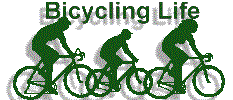There are many ways in which you and your cycling club (if you belong to one), can work
toward improvement of cycling in your area. These are often as simple as writing a
letter, or attending a public meeting. They need not take a great deal of time, but
the more effort you invest, the better your results.
We have listed some of the more worthwhile projects below and have included some links
to resources that you may find helpful. We will expand this list from time to time,
and we solicit your comments and additions.
Our focus here is on small projects where an individual or small group can make an
impact.
Send us your projects, we may put them here to serve as an
example for others. A short writeup is all we need. Email the
Projects Editor
Please note that Bicycling Life does not advocate separate facilities such as bike
paths. We think they are costly, impractical, and actually more dangerous than the
roadway. Short bikeways designed to link dead-end streets and culdesacs are a clear
exception.
Obtaining Official Recognition
Often the first goal should be to improve the visibility of bicyclists to the public.
By taking an active role of any kind, you will demonstrate that cyclists are a part of the
community Often this goes hand in hand with increased respect from police, and
better treatment at funding time before various public agencies responsible for
transportation issued.
One route toward this end is to lobby for the adaptation of an Official
State Bicycle Drivers Manual. Such a manual tends to raise cycling to a
level of "official standing" more nearly on par with motor vehicle operators.
It helps to have an official document to show police if they (incorrectly) tell you
to get on the sidewalk. (Not that we are advocating arguing with officers).
One of the best patterns for a State Bicycle Drivers Manual is the one published by
Pennsylvania. In fact the entire manual is available on the web at the Pennsylvania
Department of Transportation Website. Click Here.
Production of such a manual is not a costly undertaking, the Penn State manual is about
48 pages - 12 sheets of folded and stapled 8-1/2 x 11 paper covering the laws and safe
operation practices.
Your state could simply copy the Pennsylvania manual (after seeking license approval
from Rodale Press who supplied much of the content), make minor adjustments for
differences in statute and publish it in paper and on the web. Even allowing for the
inefficiencies of state government agencies, the entire project could be accomplished in
three months time.
How you can help:
Contact your state bicycling coordinator, and find out if your state has a bicycling
handbook. If it does not, show him a copy of the Pennsylvania Handbook or send him the
url. Learn who would have to approve such a handbook, and begin a letter-writing campaign
to accomplish that goal.
Use public meetings dealing with cycling issues as
an opportunity to present the handbook to other cyclists and public officials.
Keep in mind the goal is to have your State adopt an official "Drivers
Manual" for bicycling, one that states cyclists rights and responsibilities.
Don't accept a public safety flyer as a substitute.
Encourage Better Cycling Behavior
It is estimated that cyclist are responsible for fully two thirds of all car-bike
accidents in rural areas and at least half of such accidents in urban areas. We are
often our own worst enemy.
The behaviour of every cyclist affects all cyclists. The traffic-dodging
risk-taker leaves a mark on all of us. If you don't believe this just listen to
motorists talk about cyclist some time. They fail to notice the lawful cyclists and tend
to see the unlawful ones as being all cyclists.
There are various ways in which you can encourage better cycling practices in your
area, not the least of which is by setting a good example. Another inexpensive idea is to
hand out leaflets at cycling events. In them, you might explain the most important injury
prevention measure that every cyclist can take -- to obey the traffic laws just as if
operating a motor vehicle
An example of such a leaflet is available for download here
in MS Word Format courtesy Fred Oswald.
This example does two important things: 1) it teaches bike safety, 2) it points out
some silly laws in some parts of Ohio.
It's best to keep your handout short, and suitable for printing into a
"Tri-fold" on a single sheet of paper. Use brightly colored paper to get
attention.
Spend an evening on the web researching Your State's Bicycle laws,
and you will almost surely find some silly provisions you can add to your pamphlet to get
people thinking about the inequity of the non-standard provisions that seem to creep into
every jurisdiction's laws when it comes to bikes.
Distribute these to parents at Bike Rodeos in your area, to younger club members and
school groups whenever the opportunity presents itself.
|
